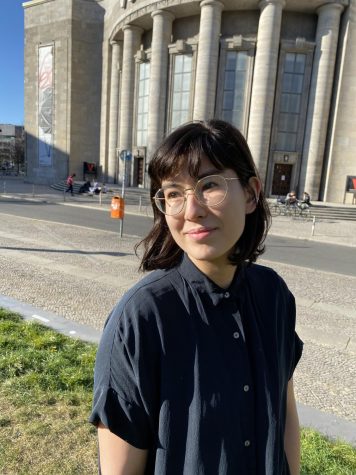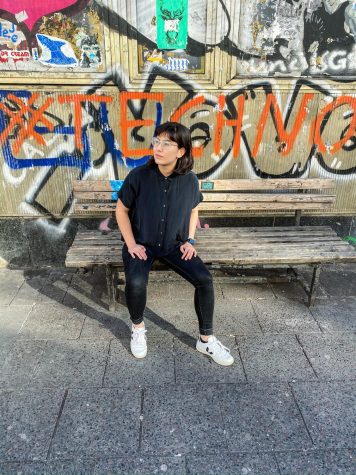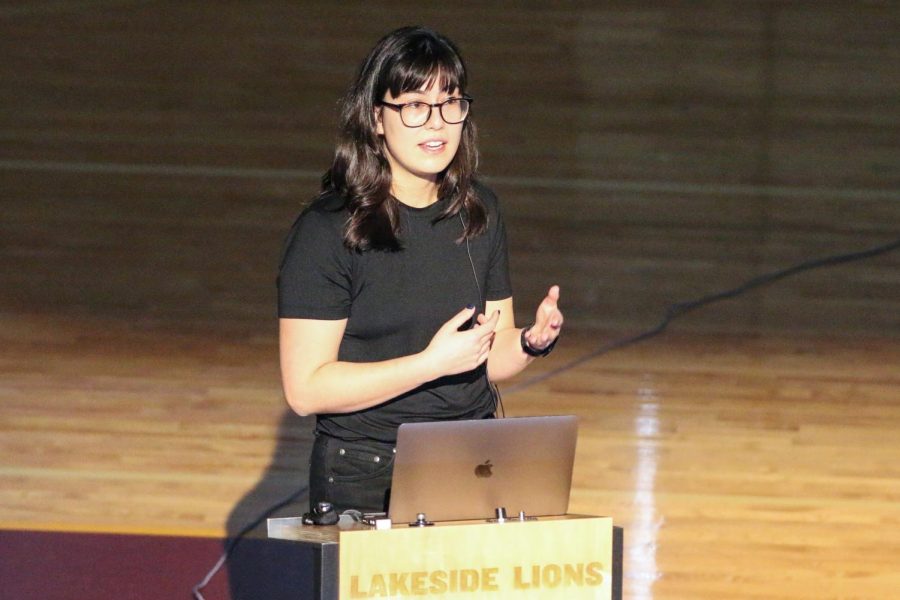Tess Rinearson ’11 on Optimism and the Crypto Winter
In March, Lakeside welcomed alum Tess Rinearson ’11 to speak about her experiences working with cryptocurrencies. After the assembly, Tatler interviewed her to hear more about her thoughts on blockchain sustainability, the work she is doing in Berlin, and her life experiences.
As a refresher, blockchains are chains of transactions that facilitate the trade of a cryptocurrency, and NFTs are tradable, unique packets of information, usually in image form.
Rohan D. ’25 (RD): Can you tell us more about the projects you worked on throughout the 2010s at Twitter, and at your previous employers as well?
Tess R. ‘11 (TR): One thing that I can talk about publicly was, um, the NFT profile picture feature. It would let users who had NFTs and who were using them as their profile photo already, sign into Twitter with their crypto wallet. They signed something that was an attestation that they’d actually owned that N F T, and then that N F T would show up to their profile picture with, but with a special hexagon shape. Before that, I had been working on a consensus algorithm, which is about how you get a lot of computers on a network to agree on what the next value of something should be. So in the blockchain space, that’s what the next block is. So again, relatively low level stuff. I also worked on the Bitcoin API, something called an enterprise blockchain, and some payment stuff. And at one point I even worked on an app for a Crypto Music Festival, which was not a super long project, but definitely one of the more memorable things.
RD: You also recently moved to Germany, right? How has that transition been, moving to a different country with a different language?
TR: Yeah, it’s been really interesting. I moved in 2019 and I spent a bunch of time kind of going back and forth between Berlin and San Francisco before I officially made the move.
Berlin is very international, so people often speak English. I am learning German, but I don’t need it that often for my day-to-day life, to be honest. I guess people say Berlin is a challenging place to live sometimes because it’s really dark in the winter. I live in a very international city with a very international group of friends, and I know a couple other Americans here, but I have many more friends who are German of course, or Swedish or Australian or, or English. So it’s quite an interesting mix.
RD: When, since you moved to Germany in 2019 — sort of — can you say what work you have done in terms of cryptocurrency or other tech jobs?
TR: So I moved to Germany in 2019 and I started working. That was when I started working on the Cosmos network, which is a proof of concept, second-generation blockchain, if you will. It was very focused on more environmentally friendly, energy-efficient consensus algorithms and then also interoperability. And so I was working with the core engineering teams on those two principal features.
RD: How is your team planning to make this second-generation blockchain more energy-efficient?
TR: Bitcoin is inefficient because it uses a consensus mechanism called proof of work. And in proof of work, you basically ensure the whole security of the network, and you agree on what transactions happen in which order. Every computer that wants to propose a new set of transactions, a new set of state changes, to the whole network, has to burn a certain amount of energy basically to earn that. You don’t get time-based conflicts like two computers arguing over who proposed a transaction. But it’s also very energy-inefficient. So if you go back to more academic computer science, there’s this whole category of research in an area of computer science called distributed systems that talks about how you can actually get computers to come to consensus in other kinds of, Now this classical area in computer science typically makes some assumptions about networks that aren’t really true (like that they’re private). So you sort of have to go back and take those algorithms and tweak them. It’s all about sort of building on classical computer science.

RD: Tying it back to Lakeside here, when you were here 10 years ago, what did you do in high school that really piqued your interest in cryptocurrencies?
I hadn’t really heard about cryptocurrency while I was at Lakeside, but there were some things that I did learn about that sort of helped lay a foundation for it.
I took a bunch of computer science classes at Lake. Um, and at the time there was really just CS one and CS two, um, and they were really hard to get into actually because there was one section of each class. Then there was this die-hard group of CS students who came together and managed to basically petition the administration for CS three.
The other thing was I took a class my senior year, which was just called advanced math. Iit was really just like a class for nerdy seniors to do kind of whatever we wanted. And so the first part of the year was, I think, multi-variable calculus and a little bit of linear algebra.
The second semester, you could pick any topic you wanted and then you had a week to lecture on it. And I picked cryptography as my area of interest. That was really the first time I thought deeply about what cryptography is and why it’s important for the internet as we know it. I was also captain of the Science Olympiad team, which was like great practice for sort of ending up in the kinds of management roles I’ve spent most of my career in.
And I actually just joined the team of a Lakeside who was one year behind me. So lots of Lakeside connections.
Can you tell us more about that Ethereum scaling company?
Essentially, we use a computational model that lets you perform more generic computations is to actually take transactions, kind of execute them somewhere else on a different set of computers, and then roll those transactions up into something called a roll up, which is basically like a summary of those transactions and really like a summary of the state changes that those transactions represent.
And then like certify that back onto the main blockchain. So you kind of get all of these like, Again, rollups happening in different places and then sort of being, you know, re retested to on, on the main Ethereum blockchain. And so I work now on a project called Optimism. The company I work for is called Op Labs and, and the project is called Optimism and um, optimism is one of the big, uh, uh, it’s like, I think, I think it’s the second biggest, but it was also I think the first, um, Ethereum scaling solution through.
I read your bio earlier and it mentioned that you had dropped out of college to work on a specific project. How was that experience, going into the unknown?
Oh yeah, that was really interesting. To be honest, part of the reason I dropped out was that I had, um, I had come to have a very high standard for my educational experience and sort of high expectations for, you know, what kinds of relationships I wanted to have with my teachers and things like that.
I went off to a big research university and I didn’t really have those kinds of connections. I also happened to go to university the year after the movie The Social Network came out.

It’s about the founding of Facebook and it made it seem really glamorous. It made it seem really, really glamorous to be, you know, Mark Zuckerberg or whoever. And I went off to the University of Pennsylvania, which has a very big business school and every student in the business school thought they were going to be the next Mark Zuckerberg.
And so they all signed up for computer science classes. And I happened to be going to faculty meetings, which is a whole other long story, and the faculty would say, “we don’t know how to teach this many students. We’re dumbing down the course material a little bit for all these business students who maybe hadn’t seen any computer science before.”
So I just became very disillusioned with the university, to be honest. So then, I had a job offer to work at Medium when it was quite small—about 25 people when I joined.
That’s kind of the thing I wanna be doing after graduation anyway, so I went off and I did it.
What did you do at Medium for those years?
I was a full stack engineer at Medium, so I did a little bit of everything, and actually that. in a roundabout way, was how I got into crypto because I found myself drawn.
I started out again, really kind of doing a little bit of everything, but I found myself drawn to working on databases—what we called at the time service oriented architecture, which is all about how you have different computers responsible for different parts of the overall software that you’re trying to build.
And I sort of got into like, how do you, how do you set up these systems and architect them? Um, and then I was like, what’s happening in the world right now? And that was partly what led me to get interested in distributed systems and consensus algorithms.
And then I got interested in crypto. So I kind of became interested in crypto in this roundabout backwards way where I wasn’t really that interested in cryptocurrency. I worked in the blockchain space for about three years before I sort of became even interested in cryptocurrency. I didn’t really buy cryptocurrency, I didn’t really care that much about the currency piece of it, but I was really interested in this consensus algorithm.
Now that I’ve been in the space a bit longer, I see how the currencies themselves do enable really interesting economic experiments like some the stuff I spoke about at Lakeside.
To the end of the economic impacts, have you ever worked on a project that also explores the economic impacts of cryptocurrency?
Most of the stuff that I have worked on has been lower level. So I myself have not been doing any of the economic stuff directly, which enables other people to go out and do some of that work.
Right now, the organization that I’m a part of is building a system called Optimism. They are experimenting with something called retroactive public goods funding, which is all about how you invest for the benefit of society rather than companies.
And the question is how do you create this incentive system where people start building things that are good for society because they know that they will get paid for it eventually? So it’s this really interesting experiment with incentives and right now it’s fairly focused on building digital infrastructure more than anything else.
So those are the kinds of public goods that get funded.
What do you see as sort of the next step for cryptocurrencies in perhaps the next five to 10 years?
Yeah, that is the big question. I think we are going to go through a period of “a crypto winter”—less interest and funding going into crypto, which I actually think is a good thing. I was talking to one of my friends who currently works as a venture capitalist investing in crypto companies.
And he said building anything in the crypto industry in these times when there’s so much interest and so much money flying is like being an engineer trying to build a bridge but there’s no gravity, so you don’t know if what you’re building is going to work in the real world. In the 2010s, there was so much money going into crypto that it obfuscated the dynamics.
This crypto winter is a good chance for people to figure out which of these economic experiments really work in the real world.
So I think we’re probably going to have a couple years of that kind of thing. But my hope and expectation is that something really cool and really impactful is going to come out of it because I think we have had a lot of fluff in the last two or three years.
From a technological standpoint as well, do you see any sort of backend advances or energy advances as coming into crypto—including what you’re working on of course?
Yeah, I think there is more of a shift towards non-proof-of-work systems. For example, most of the blockchains that have launched in the past several years haven’t used proof of work. I view that as a win.
The other thing is from a user experience perspective. I think people sometimes talk about the blockchain as if there’s only one, but it’s this really complicated network of sort of connected but not totally connected distinct networks. When I was at Twitter, I really saw how confusing this was for people, so I think we’re going get to this point where people will be able to use cryptocurrencies and blockchain networks without really needing to think about exactly how they’re connected.
It will sort of all flow together like one big internet of money rather than feeling like all of these siloed projects. So that’s one of the things I’m most excited about technically.
Is there anything else you want to mention?
The only other thing I’ll mention is that I have been so impressed with every one of the students I’ve spoken to. I sat in on one of the CS five classes and watched a bunch of their demos. I thought the demos were great. They were super interesting technically, but also funny and culturally relevant.
So I was really, really tickled by that. I had lunch with the CS Club and the Women in STEM Club, and the questions they asked were super insightful, both about what different kinds of technology mean for society, but some of the technical fundamental questions were really insightful.
I had a great day, and I feel like the current batch of Lakeside students is just gonna knock everyone’s socks off.
Thank you for taking the time to speak to us today!
Thank you for having me!
Ever since his little incident in April 26, 1986, Rohan Dhillon has been on the run from a variety of governmental agencies and human rights organizations—...

